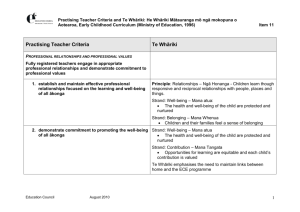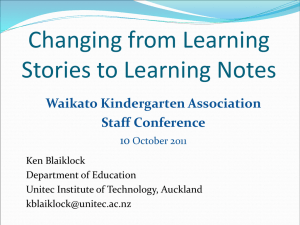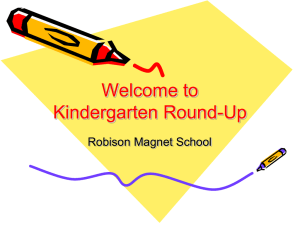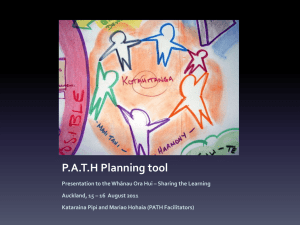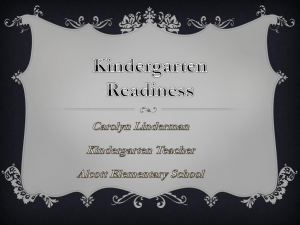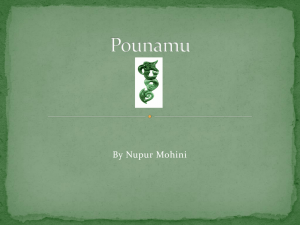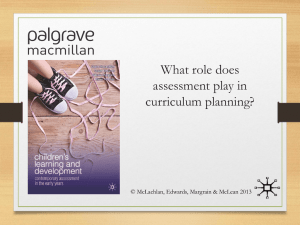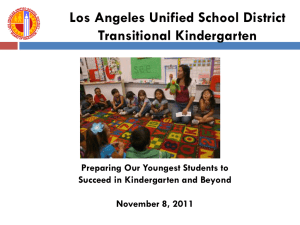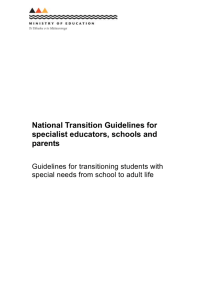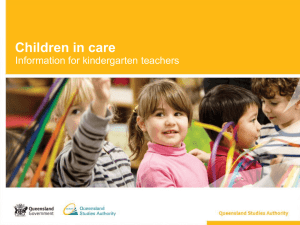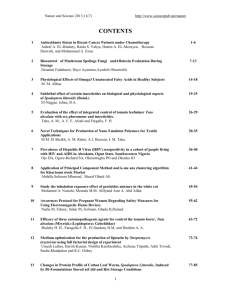Camberley Kindergarten presentation
advertisement
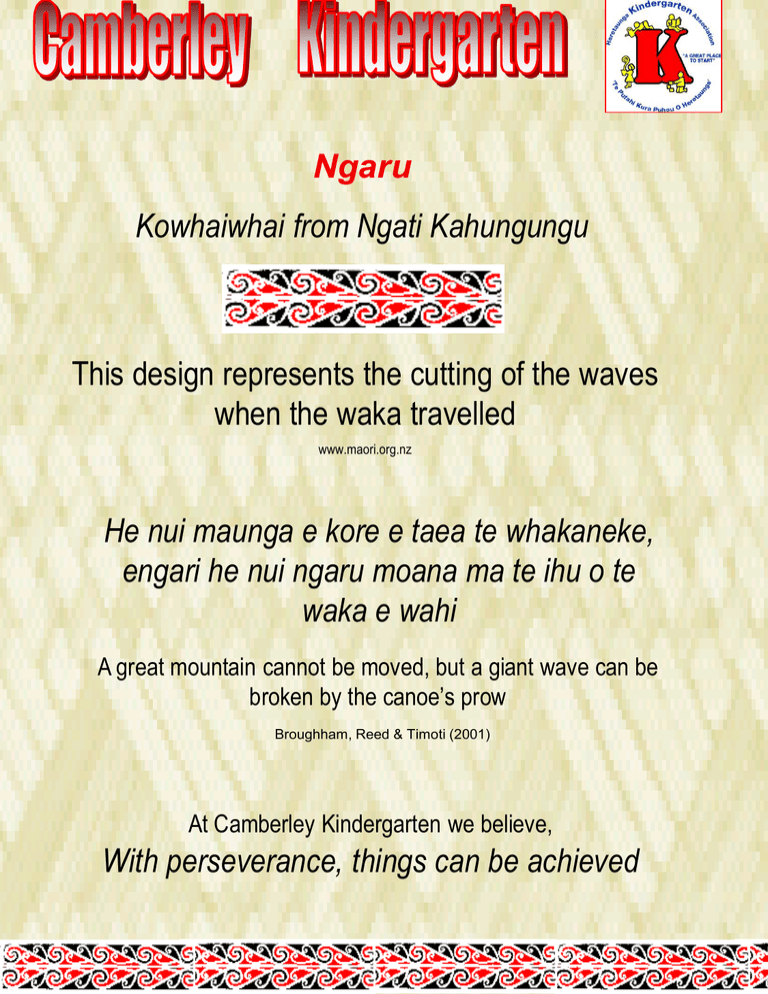
Ngaru Kowhaiwhai from Ngati Kahungungu This design represents the cutting of the waves when the waka travelled www.maori.org.nz He nui maunga e kore e taea te whakaneke, engari he nui ngaru moana ma te ihu o te waka e wahi A great mountain cannot be moved, but a giant wave can be broken by the canoe’s prow Broughham, Reed & Timoti (2001) At Camberley Kindergarten we believe, With perseverance, things can be achieved Centre Philosophy Welcoming environment, challenging and supporting children in their learning Responsive relationships that support independence, cooperation and thoughtfulness towards others We value, respect and actively seek the involvement of parents and whānau Ko koutou ki tēnā, ko mātou ki tēnei kīwai o te kete With you at that and us at this handle of the basket (we can work together to contribute to your child’s growth as a competent and confident learner) Ahakoa he iti, he pounamu Pounamu, like tamariki, is a precious taonga… Tamariki are gifted to us by our tīpuna, born already knowing, their learning beginning at conception Both pounamu and tamariki have origins of potential and possibility… Both have the potential to, be shaped, maintain cultural continuity, break down barriers, cement meaningful relationships and reflect love… Both have the possibility to become national icons, reflecting Aotearoa as a unique place known for its precious gifts of pounamu and Te Whāriki, which focuses on the unique characteristics of ngā pepe me ngā tamariki as… “competent and confident learners…(who will) make a valued contribution to society” Adapted from Rita Walker, Te Tari Puna Ora o Aotearoa Hui, 2001 Head Teacher : Hayley Whitaker B. Ed (teaching) ECE, PG Dip (ECE) Kia ora koutou. I am born and bred in Hastings though my Mum is from England and my Dad has iwi affiliations in Te Arawa. I live in Hastings with my partner Marty who has two children, Logan and Holly, who stay with us part time. I like to spend time riding motorbikes and hanging out at the beach. Teacher : Pam Standen Diploma of Teaching (ECE) I was born and have lived most of my life in Hastings and now live in Napier with my husband Ross. We have two adult sons who are living overseas at present. I love nature and the outdoors and am keen on camping and gardening. Teacher : Lynda Cushing Diploma of Teaching (ECE), B. Ed Kindergarten Support : Debbie Wroe I was born and bred in Hawkes Bay. I live in Hastings with my husband Jeremy and two children Bradley and Teagan. We enjoy going to the beach as a family. I also enjoy riding horses in my spare time. How Things Work Afternoon and Morning Tea Children at both sessions are offered fruit for their snack. We ask that you help us out by bringing a few pieces of fruit a week. We supply morning children with sandwiches half way through the session since it is such a long morning. Lunch Days On Fridays the morning children bring their lunch to eat at kindergarten. Some healthy choices that you can provide in their named lunch box may include sandwiches, fruit, yoghurt, crackers. 5th Birthday We celebrate your child’s 5th birthday and move to the next exciting phase of his/her life with a dough cake and birthday hat. Children share popcorn that we make for them and sing farewell and birthday songs. Change of Clothes Please send a change of clothes with your child each day in case of toileting mishaps, water play and other messy activities. Your Role You are always welcome to come and spend time at kindergarten with your child. It is great to have a spare set of hands to help out too. Occasionally we may ask you to have a turn at taking the washing home on a Friday and/or the dolls and dress up clothes at the end of the term. Please let us know if your child will be absent or if they are finishing. Committee We really value family input in the running of our kindergarten. Being part of the committee is stress free and you can bring your children along with you. Notices about the dates of meetings are in the newsletter and on the whiteboard. Te Whāriki Our curriculum was written specifically for Aotearoa to reflect our unique bicultural heritage. All children living in Aotearoa should be given the opportunity to develop knowledge and understanding of the cultural heritages of both partners of Te Tiriti o Waitangi. Te Whāriki recognises that curriculum is provided by the people, places and things in the child’s entire environment including the adults, the other children, the physical environment and the resources. Our curriculum has been envisaged as a whāriki, or mat, woven from the four principles and with input from all those in the learning community. Decisions about learning and teaching should reflect our bicultural heritage and made in consultation with appropriate tangata whenua (Te Whāriki, MOE, 1996, pp 9, 11) Whakamana Empowerment Children who experience a curriculum that empowers them as competent and confident learners are likely to develop a strong sense of who they are and their place in the world. Whakamana is the process of nurturing the mana of children. This involves acknowledging and valuing the uniqueness of each child – the skills and knowledge they bring and the contribution they make to their whānau and the early childhood education setting. Empowerment is about giving children choices, encouraging them in their decision making and promoting critical thinking. Adults who empower children allow them to take risks, experience success and failure, make mistakes and take increasing initiative and responsibility. Kotahitanga Holistic Development All aspects of a child’s learning are interrelated and interconnected. Māori world views recognise that holistic learning occurs through the connections between te taha hinengaro (mental well being), te taha wairua (spiritual well being), te taha tinana (physical well being), te taha whānau (social well being) and whatumanawa (emotional well being). Children construct their understanding of the world from a range of connected and increasingly complex experiences. These understandings grow and change as children make meaning of their experiences and as they observe the roles and models of people around them. When teachers allow experiences to extend over time, children have opportunities to build on, change or reconstruct their learning. Ngā Hononga Relationships Close relationships develop in early childhood education services when teachers work with groups of children and adults and children get to know each other very well. Children’s potential to engage in meaningful and relevant learning experiences is enhanced when the relationships are caring and supportive. Engagement is critical for children’s learning. Being engaged in learning involves making meaningful connections and relationships with people, places, things and time. Teachers create opportunities for engaged learning that involves reciprocal relationships (the concept of ako) between children and adults, children and their peers and children and the environment. Teachers recognise that values such as respect, empathy, generosity and caring for others affect behaviour and influence how children engage with people, places, things and time. Whānau Tangata Family and Community Whanaungatanga embraces the concept of relationships and recognises that each child has relationships that are a source of learning, empowerment and identity. Many of these relationships are expressed in the whakapapa of each child. Whanaungatanga is the process of supporting and strengthening relationships that are significant to children and to their whānau, family, hapu and iwi. The process is built on values such as respect, empathy, sharing and caring for others. This process contributes to the learning of all children. Learning experiences become meaningful and purposeful when they are connected to the child’s world, e.g. to their family, their culture or their past experiences. Assessment for Learning The four principles of Te Whāriki are also the principles for assessment. Assessment for is described as noticing, recognising and responding (MOE, 2004). Assessment for learning requires teachers to know the children and their families very well. Notice : Observe Teachers notice what children are doing, interested in and engaged in. Recognise : Assess Teachers then recognise the learning that is occurring for the child or children, reflecting on what it tells them about children’s learning, making links to theories, content knowledge, Te Whāriki etc. Respond : Plan Teachers respond to children’s interests and learning, both at the time, in the moment, and for the future. They reflect on what they did, could have done and could do in the future to extend children’s learning and interest?
